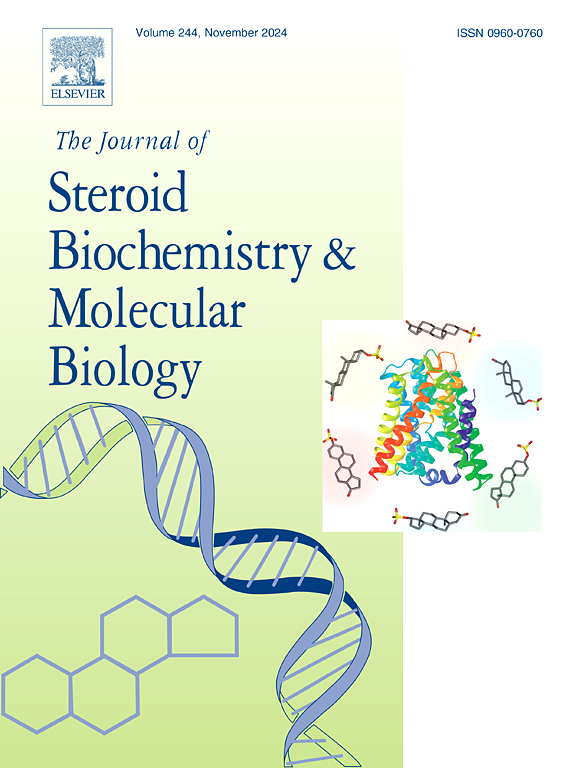Signaling crosstalk of Galectin-3, β-catenin, and estrogen receptor in androgen-independent prostate cancer DU-145 cells
IF 2.7
2区 生物学
Q3 BIOCHEMISTRY & MOLECULAR BIOLOGY
Journal of Steroid Biochemistry and Molecular Biology
Pub Date : 2025-01-21
DOI:10.1016/j.jsbmb.2025.106679
引用次数: 0
Abstract
The aims of this study were to investigate the localization of non-phosphorylated β‑catenin and Galectin-3 (GAL-3), the regulation of the expression of both proteins by activation of estrogen receptors (ERs) and their role in tumorigenic characteristics of androgen-independent prostate cancer DU-145 cells. DU-145 cells were cultured in the absence (control), and presence of 17β-estradiol (E2). Cells were also untreated or pre-treated with the inhibitor of GAL‑3, VA03, or with a compound that disrupts the complex β-catenin-TCF/LEF transcription factor, PKF 118–310. Immunofluorescence assay for non-phosphorylated β-catenin and GAL-3, cell proliferation, wound healing and cell invasion assays were performed. 17β-estradiol (E2, 4 h) increased the expression of non-phosphorylated β-catenin and GAL-3. E2 also increased (2-fold) the co-localization of the fluorescence of non-phosphorylated β-catenin and GAL‑3 in the whole cells compared to the control. The up-regulation of non-phosphorylated β-catenin expression was blocked by VA03, suggesting that GAL-3 is upstream protein involved in this process. E2 (24 h) increased the cell number, migration, and invasion of the DU‑145 cells compared to control. Furthermore, PKF 118–310 completely blocked the proliferation, migration, and invasion of the DU-145 cells induced by activation of ERs. The activation of ERs increases the expression, co-localization and signaling of the GAL-3 and non-phosphorylated β-catenin in DU-145 cells. Non-phosphorylated β-catenin is downstream protein involved in proliferation, migration, and invasion of the DU‑145 cells.
雄激素非依赖性前列腺癌DU-145细胞中半乳糖凝集素-3、β-连环蛋白和雌激素受体的信号串扰。
本研究的目的是研究非磷酸化β -连环蛋白和半乳糖凝集素-3 (GAL-3)的定位,雌激素受体(er)激活对这两种蛋白表达的调节及其在雄激素非依赖型前列腺癌DU-145细胞的致瘤特性中的作用。分别在17β-雌二醇(E2)存在和不存在的情况下培养DU-145细胞。细胞也用GAL‑3抑制剂VA03或破坏复合物β-catenin-TCF/LEF转录因子PKF 118-310的化合物进行未经处理或预处理。进行非磷酸化β-catenin和GAL-3的免疫荧光检测、细胞增殖、伤口愈合和细胞侵袭试验。17β-雌二醇(E2, 4h)增加非磷酸化β-catenin和GAL-3的表达。与对照组相比,E2还增加了全细胞中非磷酸化β-catenin和GAL - 3荧光的共定位(2倍)。非磷酸化的β-catenin表达上调被VA03阻断,提示GAL-3是参与这一过程的上游蛋白。与对照组相比,E2 (24h)增加了DU‑145细胞的数量、迁移和侵袭。此外,PKF 118-310完全阻断了er活化诱导的DU-145细胞的增殖、迁移和侵袭。内质网的激活增加了GAL-3和非磷酸化β-catenin在DU-145细胞中的表达、共定位和信号传导。非磷酸化β-catenin是参与DU - 145细胞增殖、迁移和侵袭的下游蛋白。
本文章由计算机程序翻译,如有差异,请以英文原文为准。
求助全文
约1分钟内获得全文
求助全文
来源期刊
CiteScore
8.60
自引率
2.40%
发文量
113
审稿时长
46 days
期刊介绍:
The Journal of Steroid Biochemistry and Molecular Biology is devoted to new experimental and theoretical developments in areas related to steroids including vitamin D, lipids and their metabolomics. The Journal publishes a variety of contributions, including original articles, general and focused reviews, and rapid communications (brief articles of particular interest and clear novelty). Selected cutting-edge topics will be addressed in Special Issues managed by Guest Editors. Special Issues will contain both commissioned reviews and original research papers to provide comprehensive coverage of specific topics, and all submissions will undergo rigorous peer-review prior to publication.

 求助内容:
求助内容: 应助结果提醒方式:
应助结果提醒方式:


